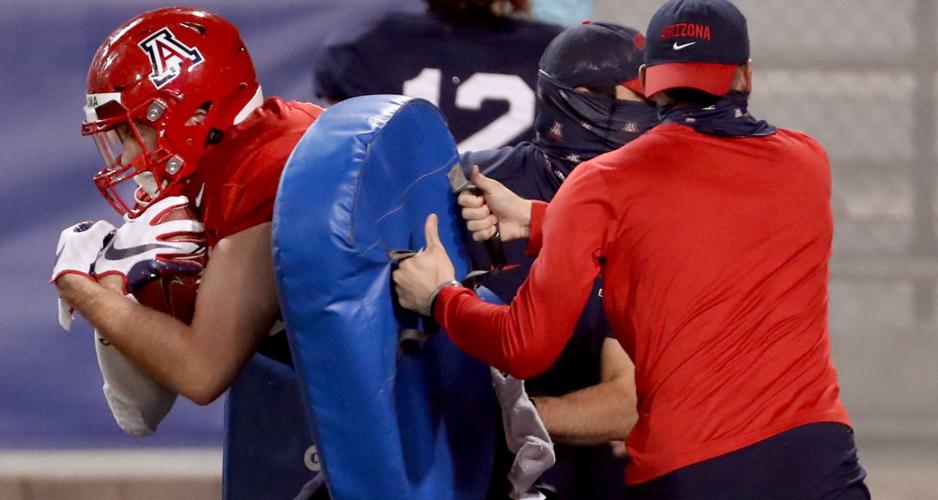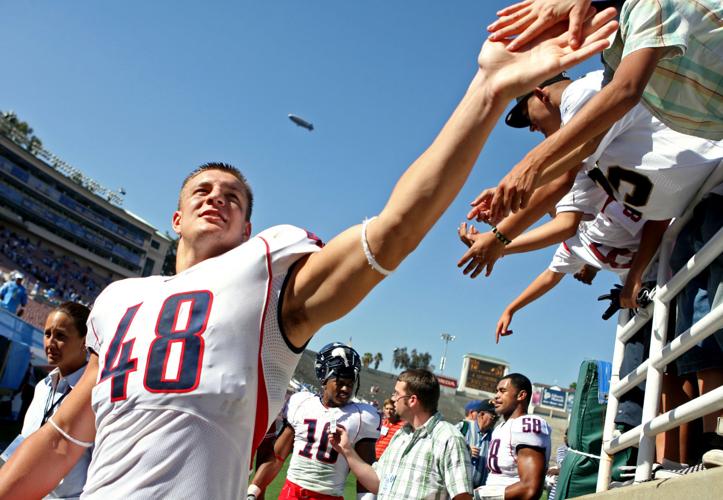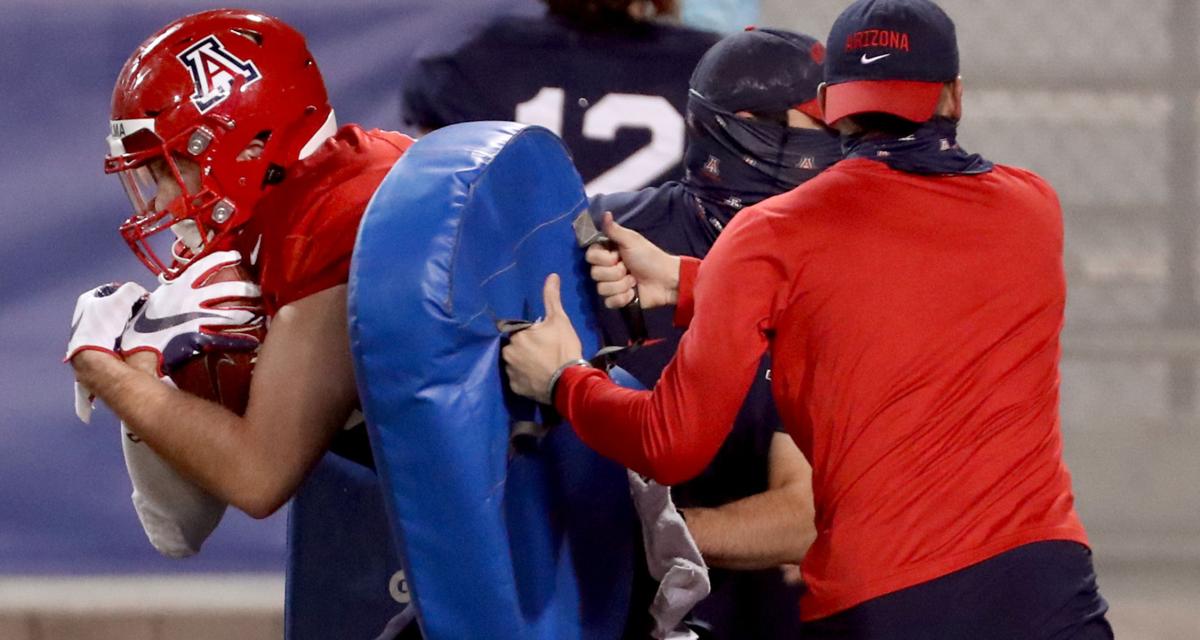In his two healthy seasons as an Arizona Wildcat, Rob Gronkowski caught 16 touchdown passes.
In the 13 seasons since then, UA tight ends have caught ... 16 touchdown passes. And we’re using the term “tight end” pretty loosely here.
We’re including Terrence Miller, who was more of a hybrid player (wide receiver/tight end). And Taimi Tutogi, who was more of an H-back. And the 2014 season of Austin Hill, who played the Miller role for part of that campaign.
Any way you parse it, the tight end position hasn’t been a prominent part of Arizona’s passing game since the heyday of Gronkowski, who went on to become one of the greatest tight ends in NFL history. He’s about to play in his fifth Super Bowl.
But after years of false promises and empty rhetoric, the role of the tight end at Arizona is about to change. New coach Jedd Fisch is determined to find and develop more Gronkowskis. And Fisch is backing up his words with actions.
To start with, Fisch hired an assistant coach, Jordan Paopao, whose primary duty is to coach tight ends.
“The commitment ... starts with having an actual position coach,” said Paopao, who has tutored tight ends for the past 10 seasons at Washington and UNLV. “You get to install, you get to mold, you get to influence. You get a model of consistency.”
When he officially announced the addition of Paopao to the staff, Fisch said: “Jordan has been an unbelievable developer of talent and will help us produce more NFL tight ends, hopefully similar to the one who is currently playing for the Buccaneers.”
That was a reference to Gronkowski, and it isn’t the only one Fisch has made. In a media interview to discuss the staff and other matters, Fisch alluded to Gronkowski’s enduring impact in New England, where Fisch coached before taking the UA job.

Tight end Rob Gronkowski caught 16 touchdown passes during his two healthy years at UA. That’s as many touchdowns as Arizona tight ends have scored in the 13 years since.
“When you’ve got guys like Rob Gronkowski (who are) part of this program in the past, I recognize from being a Patriot how important that guy is,” Fisch said. “We’re gonna have to do our best to find someone similar.”
When Gronkowski revealed he’d return for another season, Fisch tweeted: “Not only will he be back in the NFL next year, I was thinking we invite him back to be the head coach of one of the teams in the spring game. Just a thought ...”
UA athletic director Dave Heeke took it a step further after Tampa Bay made the Super Bowl, tweeting congratulations to Gronkowski before adding: “Look forward to having you in Tucson to see what @CoachJeddFisch and @ArizonaFBall are assembling!”
Gronkowski rarely has been back to Tucson since he was drafted more than 10 years ago. The new regime is seeking to rebuild that relationship.
Critical to success
It’s one thing to talk about using the tight end; it’s another to actually do something about it.
Fisch’s predecessors, Rich Rodriguez and Kevin Sumlin, talked a good game when asked about incorporating the tight end. But it never happened with any degree of consistency.
Rodriguez carved a role for the 6-foot-4-inch, 233-pound Miller, who notched career highs with 40 catches for 467 yards in 2013.
But Miller was never a Gronk-esque red-zone weapon under Mike Stoops or Rodriguez, scoring only three touchdowns among 95 career receptions.
The arrival of freshman Bryce Wolma in 2017 seemed to signal a tight end revival. He caught 28 passes for 241 yards and a touchdown that season. Teammates Jamie Nunley and Trevor Wood chipped in eight more catches for 173 yards and two scores.
But tight end usage dropped to nearly nonexistent levels under Sumlin and offensive coordinator Noel Mazzone. Tight ends totaled 18 receptions over the past three seasons. Wolma’s four catches last year netted 4 yards. He rarely ran routes beyond the line of scrimmage.
“I’ve really never been part of a program that wasn’t tight end-driven,” Fisch said. “When you throw four wide receivers and a running back out there, you’ve guaranteed that it’s going to have to be a five- or six-man protection; there’s no chance of it being a seven-man protection. When you don’t have a tight end in the running game, it really causes some mismatches and makes it challenging to be able to run the football. Not really a fan of that.
“Also, the diversity it brings when you can get a bigger tight end that can stretch the field and challenge defenses down the middle. It adds a dimension and a weapon that is pretty critical to the success of our program.”
Fisch has been a passing-game coordinator or offensive coordinator in eight seasons in college and the NFL.
His top tight end had at least 25 receptions in seven of those campaigns. The last time he ran an offense, at UCLA in 2017, the top three tight ends combined for 73 catches, 865 yards and five touchdowns.
Offers out
Wolma is returning for a fifth season. He was attracted by the idea of being something more than a blocker.
“All signs (are) leading to more production, which I’ve been waiting on for three years,” Wolma said. “So can’t leave now.”
Wolma is joined in the tight end room by Stacey Marshall Jr., a junior-college transfer who played 23 snaps in two games last season and didn’t catch a pass; and redshirt sophomore Zach Williams, who played 33 snaps in three games and caught two passes for 24 yards.
The lone tight end in Arizona’s 2021 signing class, three-star recruit Colby Powers of Spring, Texas, will arrive later this year. More tight ends are on the way.
In little over a month’s time, Fisch and his staff have sent scholarship offers to six tight end prospects in the class of ’22. Arizona averaged 7.7 offers to tight ends over the previous six full recruiting cycles, per 247Sports’ database.
Paopao — who coached future NFL draft picks Austin Seferian-Jenkins, Will Dissly and Drew Sample at Washington — views tight end as the second-hardest position to play besides quarterback. It requires strength, athleticism and football intelligence — traits Gronkowski has translated into a Hall of Fame career.
“It’s really the commitment to whatever is being asked of you,” Paopao said. “You are an offensive lineman, but you’re also a receiver. You need to know how to manipulate zones and where to be able to fit things.
“That’s why it’s such a unique challenge that I’m always so passionate about. It is the ultimate position on the offensive side of the football, and I believe that wholeheartedly.”






